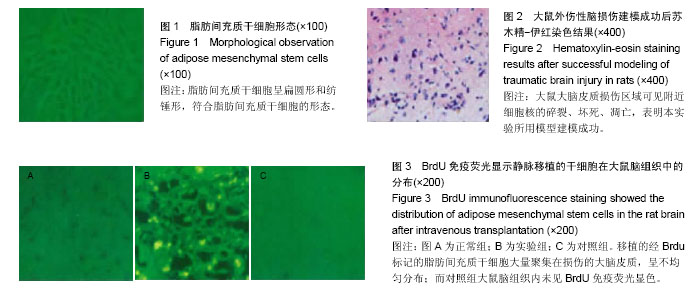| [1] Abu-Abeeleh M, Bani Ismail ZA, Alzaben KR,et al. A preliminary study of the use of human adipose tissue-derived stem cells for the treatment of streptozotocin-induced diabetes mellitus in a rat model. Comp Clin Pathol.2010; 19(1):1-4.[2] Hess DC,Borlongan CV.Stem cells and neurological diseases. Cell Prolif.2008;41Suppl 1:94-114.[3] Chen Z,Palmer TD.Cellular repair of CNS disorders: an immunological perspcetive.Hum Mol Genet.2008;17(Rl): R84-R92.[4] Longhi L,Zanier ER,Royo N,et al.Stem cell transplantation as a therapeutic strategy for traumatic brain injury.Transpl immunol. 2005;15(2):143-148.[5] Bjorklund LM,Sanchez-Pernaute R,Chung S,et al.Embryonic cells develop into functional dopaminergic neurons after transplantation in a parkinson rat model.Proc Natl Acad Sci USA.2002;99(4):2344-2349.[6] Gregory CA,Gunn WG,Peister A,et al.An Alizarin red-based assay of mineralization by adherent cells in culture: comparison with cetylpyridiniurn chloride extraction.Ana lBiochem.2004;329(1):77-84.[7] Hayashi O,Katsube Y,HiroseM,et al.Comparison of osteogenic ability of rat mesenchymal stem cells from bone marrow,periosteum,and adipose tissue.Caleif Tissue Int. 2008;82 (3): 238-247.[8] Planat-Benard V,Silvestre JS,Cousin B,et al.Plasticity of human adipose lineage cells toward endothelial cells: Physiological and therapeutic perspectives. Cireulation. 2004; 109(5):656-663.[9] Zuk PA,Zhu M,Mizuno H,et al.Multilineage cells from human adipose tissue: implications for cell-based therapies.Tissue Eng.2001;7(2):211-228.[10] Safford KM,Safford SD,Gimble JM,et al.Characterization of neuronal/glial differentiation of murine adipose-derived adult stromal cells.Exp Neurol.2004;187(2):319-328.[11] Dhar S,Yoon ES,Kachgal S,et al.Long-term maintenance of neuronally differentiated human adipose tissue-derived stem cells.Tissue Eng.2007;13(11):2625-2632.[12] Safford KM,Hieok KC,Saflbrd SD,et al.Neurogenic differentiation of murine and human adipose-derived stromal cells.Bioehem Biophys Res Commun.2002;294(2): 371-379.[13] Casteilla L,Planat-Benard V,Cousin B,et al.Plasticity of adipose tissue:a promising therapeutic avenue in the treatment of cardiovascular and blood diseases?.Aich Mal Coeur Vaiss.2005;98(9):922-926.[14] Oedayrajsingh-Vanna MJ,Van HS,KniPPenberg M,et al. Adipose tissue-derived mesenchymal stem cell yield and growth charaeteristics are affected by the tissue-harvesting procedure. CytotheraPy.2006;8(2):166-177.[15] Hombach-Klonisch S,Panigrahi S,Rashedi I,et al.Adult stem cells and their trans differentiation potential-perspeetives and therapeutic applications.J Mol Med.2008.[16] 中华人民共和国科学技术部.关于善待实验动物的指导性意见. 2006-09-30.[17] Grasso G,Sfacteria A,Meli F,et al.Neuroprotection by erythropoietin administration after experimental traumatic brain injury.Brain Res.2007;1182:99-105.[18] Bhang SH,Lee YE,Cho SW,et al.Basic fibroblast growth factor promotes bone marrow stromal cell transplantation-mediated neural regeneration in traurnatic brain injury.Biochem BioPhys Res Commun.2007;359(l):40-45.[19] Gotherstrom C,Ringden O,Tammik C.et al.Immunologic ProPerties of human fetal mesenchmal stem cells.Am J Obstet Gyneeol.2004;190:239-245.[20] Booekvar JA,Sehouten J,Royo N,et al.Experimental traumatic brain injury modulates the survival,migration,and terminal phenotype of transplanted epidermal growth factor receptor- aetivated neural stem cells. Neurosurgery. 2005;56(1): 163-171,171.[21] Chen X,Katakowski M,Li Y,et al.Human bone marrow stromal cell cultures conditioned by traurnatic brain tissue extracts: growth factor produetion.J Neurosci Res.2002; 69(5): 687-691.[22] Harting MT,Baumgartner JE,Worth LL,et al.Cel ltherapies for traumatic brain injury. Neurosurg Focus.2008;24(3-4):E18.[23] Jiang Y,Jahagirdar BN,Reinhardt RL,et al.Plurpotency of mesenchymal stem cells derived from adult marrow. Nature. 2002;418(6893):41-49.[24] Kogler G,Sensken S,Airey JA,et al.A new human somatic stem cell from placental cord blood with intrinsic Pluripotent differentiation potential.J ExP Med.2004;200(2):123-135.[25] Zvaifler NJ,Marinova-Mutafchieva L,Adams G,et al. Mesenchymal precursor cells in the blood of normal individuals. Arthritis Res.2000;2(6):477-488.[26] Jiang Y,Vaessen B,Lenvik T,et al.MultiPotent progenitor cells can be isolated from postuatal murine bone marrow,musele, and brain. ExP Hematol.2002;30(8):896-904.[27] Pittenger MF,Mackay AM,Beck SC,et al.Multilineage Potential of adult human mesenchymal stem cells.Seienee. 1999; 254(5411):143-247.[28] Kamishina H,Farese JP,Storm JA,et al.The frequency,growth kinetics,and osteogenice/ adiPogenic differeniiation pro Perties of canine bone marrow stromal cells.In Vitro Cell Dev Biol Anim.In Vitro Cell Dev Biol Anim. 2008;44(10):472- 479.[29] Baksh D,Yao R,Tuan RS.Comparison of Proliferative and multilineage differentiation Potential of human mesenchymal stem cells derived from ulnbilical cord and bone marrow. Stem Cells.2007;25(6):1384-1392.[30] Yamaguehi S,Kuroda S,Kobayashi H,et al.The effects of neuronal induction on gene expression profile in bone marrow stromal cells(BMSC)-a preliminary Study using mieroarray analysis. Brain Res.2006;1087(l):15-27.[31] LewinGR,Barde YA.Physiology of the neurotrophins.Annu Rev Neurosci.1996;19:289-317.[32] Bowling H, Bhattacharya A, Klann E,et al.Deconstructing brain-derived neurotrophic factor actions in adult brain circuits to bridge an existing informational gap in neuro-cell biology. Neural Regen Res. 2016;11(3): 363-367.[33] Lv XM,Liu Y,Wu F,et al.Human umbilical cord blood-derived stem cells and brain-derived neurotrophic factor protect injured optic nerve: viscoelasticity characterization. Neural Regen Res. 2016;11(4): 652-656.[34] Yamada K,Nabeshima T.Brain-derived neurotrophic factor/TrkB signaling in memory Processes.J Pharmacol Sci.2003;91(4):267-270.[35] Saarelainen T,Pussinen R,KoPonen E,et al.Transgenic mice overexpressing truneated trkB neurotrophin receptors in neurons have impaired long-term spatial memory but normal hippocampal LTP.Synapse.2000;38(l):102-104.[36] Saarelainen T,Lukkarinen JA,KoPonen S,et al.Transgenic mice overexpressing truncated trkB neurotrophin receptors in neurons show inereased susceptibility to cortical injury after focal cerebral ischemia.Mol Cell Neurosci.2000;16(2):87-96.[37] Lin LF,Doherty DH,Lile JD,et al.GDNF:a glial cell line-derived neurotrophic faetor for midbrain dopaminergic neurons. Science.1993;260(5111):1130-1132.[38] 闫中杰.人羊膜及脐带来源间充质干细胞对创伤性脑损伤治疗潜力的生物学特性比较[D].南方医科大学,2013.[39] 李东飞.静脉移植脂肪间充质干细胞治疗大鼠创伤性脑损伤[D].南方医科大学,2010.[40] Cheng Q,diLiberto V,Caniglia G,et al.Time-eourse of GDNF and its receptor expression after brain injury in the rat. Neurosci Lett. 2008;439(l):24-29.[41] Fujimoto T,Nakamura T,Ikeda T,et al.Potent protective effects of melatonin on experimental spinal cord injury.Spine(Phila Pa 1976).2000;25(7):769-775.[42] Saavedra A,BaltaZar G,Duarte EP.Driving GDNF expression: the green and the red traffic lights.Prog Neurobiol.2008; 86(3): 186-215. |
.jpg)


.jpg)